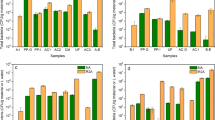Abstract
Concern over the prevalence of active pharmaceutical agents and subsequent occurrence of antimicrobial resistance in the environment is increasing. Incorruptible ability of Ganga water was evaluated using fresh, 8-year-old, and 16-year-old Ganga water samples spiked with pathogenic Escherichia coli serotype O157:H7. Survival of E. coli O157:H7 over the course of the experiment was 3, 7, and 15 days for fresh, 8-year-old, and 16-year-old Ganga waters, respectively. On the contrary, in Milli Q water the decline in viable count of E. coli O157:H7 up to 30 days was only 2 log units. Survival of E. coli O157:H7 was greater in boiled water compared with water after passage through a 0.2-μm-pore-size membrane filter, indicating involvement of heat-labile agents influencing survival of E. coli O157:H7 in Ganga water, which seems to indicate the role of antimicrobial peptides. Functional diversity of Ganga water’s native microbial community structure as assessed with Biolog Eco plates was not affected even in the presence of a 5-fold log units higher pathogenic load of E. coli O157:H7. These findings suggest that Ganga water has certain novel antimicrobial attributes, besides its remarkable fluidity, which may provide a much-needed basis for the development of new antimicrobial compounds.


Similar content being viewed by others
References
Aitken MD, Sobsey MD, Van Abel NA et al (2007) Inactivation of Escherichia coli O157:H7 during thermophilic anaerobic digestion of manure from dairy cattle. Water Res 41:1659–666
Beauchamp CJ, Simao-Beaunoir AM, Beaulieu C et al (2006) Confirmation of E. coli among other thermotolerant coliform bacteria in paper mill effluents, wood chips screening rejects and paper sludges. Water Res 40:2452–2462
Chart H (2000) VTEC enteropathogeicity. J Appl Microbiol 88:12S–23S [Symposium Supplement]
Darian SG (1978) The Ganges in myth and history. University Press of Hawaii, Honolulu
DasGupta SM, Chauhan PS, Nautiyal CS (2007) Search for an ever elusive “guardian-angel” novel antibiotic: myth or reality. In: Chauhan AK, Kharkwal H, Verma A (eds) Microbes for human life. IK International, New Delhi, pp 311–335
D’Herelle F (translated to English by Smith GH) (1922) The bacteriophage: its role in immunity. Williams and Wilkins/Waverly Press, Baltimore
Flint KP (1987) The long-term survival of Escherichia coli in river water. J Appl Bacteriol 63:261–270
Garland JL (1996) Analytical approaches to the characterization of samples of microbial communities using patterns of potential C source utilization. Soil Biol Biochem 28:213–221
Garland JL, Mills AL (1991) Classification and characterization of heterotrophic microbial communities on the basis of patterns of community-level sole-carbon-source utilization. Appl Environ Microbiol 57:2351–2359
Häusler T (2006) Viruses vs. superbugs: a solution to the antibiotics crisis? Macmillan Science, New York
Kloss J (1939) Back to Eden. Back to Eden books, Loma Linda
Lerner CG, Hajduk PJ, Wagner R et al (2007) From bacterial genomes to novel antibacterial agents: discovery, characterization, and antibacterial activity of compounds that bind to HI0065 (YjeE) from Haemophilus influenza. Chem Biol Drug Des 69:395–404
Liberman D, Berman T (2006) Analysis and monitoring: MSC—a biologically oriented approach. Filtrat Sep 43:439–440
Lock RL, Harry EJ (1994) Cell-division inhibitors: new insights for future antibiotics. Nature Rev Drug Dis 7:324–338
McMahan ZH, Dupont HL (2007) The history of acute infectious diarrhea management—from poorly focused empiricism to fluid therapy and modern pharmacotherapy. Aliment Pharmacol Ther 25:759–769
Nautiyal CS, Chauhan PS, Nene YL (2007) Medicinal smoke reduces airborne bacteria. J Ethnopharmacol 114:446–451
Nautiyal CS, Govindarajan R, Lavania M et al (2008) Novel mechanism of modulating natural antioxidants in functional foods: involvement of plant growth promoting rhizobacteria NRRL B–30488. J Agr Food Chem 56:4474–4481
Rossi LM, Rangaswamy P, Zhang J et al (2008) Research advances in the development of peptide antibiotics. J Pharm Sci 97:1060–1070
Sharma Y (1997) The Ganga, India. In: Helmer R, Ivanildo H (eds) Water pollution control—a guide to the use of water quality management principles. WHO/UNEP, Geneva
Sheridan C (2006) Antibiotics au naturel. Nat Biotechnol 24:1494–1496
Staddon WJ, Duchesne LC, Trevors JT (1997) Microbial diversity and community structure of post disturbance forest soils as determined by sole-carbon-source utilization patterns. Microb Ecol 34:125–130
Vicente M, Hodgson J, Massidda O et al (2006) The fallacies of hope: will we discover new antibiotics to combat pathogenic bacteria in time? FEMS Microbiol Rev 30:841–852
Acknowledgments
The author is deeply indebted to R.K. Trivedi, former Governor of the State of Gujarat, India, for providing the 16-year-old Ganga water sample; V. Sharma, King George Medical University, Lucknow, for providing the strain of E. coli O157:H7; and B. Staddon, Eastern Kentucky University, Richmond, USA for, his generous help in the Diversity/Evenness Index analysis. Thanks are due to the Director, National Botanical Research Institute, Lucknow, for the necessary support. This work was supported by the New Millennium Indian Technology Leadership Initiative (NMITLI) program and Task Force Grant NWP-0019 from the Council of Scientific and Industrial Research, New Delhi.
Author information
Authors and Affiliations
Corresponding author
Rights and permissions
About this article
Cite this article
Nautiyal, C.S. Self-Purificatory Ganga Water Facilitates Death of Pathogenic Escherichia coli O157:H7. Curr Microbiol 58, 25–29 (2009). https://doi.org/10.1007/s00284-008-9260-3
Received:
Revised:
Accepted:
Published:
Issue Date:
DOI: https://doi.org/10.1007/s00284-008-9260-3




